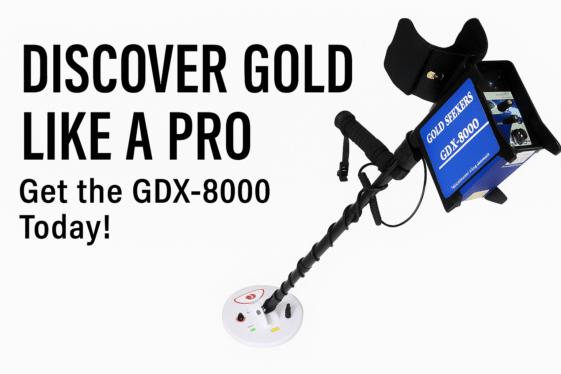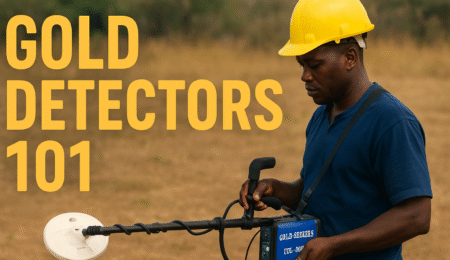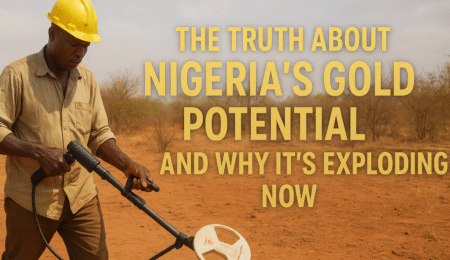Gold doesn’t just appear anywhere; it’s born deep within the Earth and carried to the surface through specific geological processes. Understanding the kinds of rocks and soils that host gold is one of the most powerful skills a prospector can have. Whether you’re an artisanal miner, investor, or landowner in Nigeria, knowing what to look for can mean the difference between striking gold and wasting months digging in the wrong place.
This guide explores the main gold-bearing rocks and soil types found in Nigeria, why they matter, and how to use modern technology like the GDX-8000 Gold Detector to identify and exploit them effectively.
1️⃣ The Geological Story of Gold in Nigeria
Nigeria’s gold wealth lies within its Precambrian Basement Complex – some of the oldest rocks on Earth, dating back over 2 billion years. These rocks, spread across states like Zamfara, Niger, Kaduna, Osun, Kwara, Kebbi, Nasarawa, and Kogi, are rich in metamorphic and igneous materials that host primary and secondary gold deposits.
The gold often occurs in quartz veins (hard rock or lode gold) or is eroded and redeposited in alluvial gravels (placer gold). Each of these formations tells a different story, and requires a different detection approach.
2️⃣ Key Gold-Bearing Rocks in Nigeria
Here are the most common types of rocks where gold is typically found across the country:
🪨 Quartz Veins
Quartz is the number one indicator of gold-bearing zones. Most of Nigeria’s hard rock gold deposits occur in milky-white quartz veins, sometimes with visible pyrite (“fool’s gold”). Areas in Ilesha (Osun State), Tsohon Birnin Gwari (Kaduna State), and Maru (Zamfara State) are rich in these formations.
Tip: When you see quartz veins cutting through schist or granite, use your GDX-8000 Gold Detector to scan the surrounding area – gold often occurs nearby in the host rock.
🪨 Schist
Schists are metamorphic rocks that host a lot of Nigeria’s primary gold. They form from ancient sediments and volcanic rocks subjected to intense pressure and heat. Zamfara, Niger, and Kebbi States have vast belts of schist that carry auriferous (gold-bearing) quartz veins.
🪨 Granite and Pegmatite
In regions like Nasarawa and Kogi, gold sometimes occurs in pegmatitic and granitic formations. Although not as rich as schists or quartz veins, these rocks often signal mineralized zones where gold may have been mobilized by hydrothermal fluids.
🪨 Greenstone Belts
Nigeria’s Schist Belts (also known as greenstone belts) are the geological equivalent of South Africa’s ancient gold provinces. These belts – particularly in the Birimian series running through the northwest and central zones, are a major exploration frontier for gold mining companies.
🟡 Thinking of exploring for gold in Nigeria? Whether you’re a miner, landowner, or investor, the GDX-8000 Gold Detector is the trusted tool transforming local gold discovery across Nigeria and West Africa.
Detect deeper, find faster, and uncover real opportunities beneath your land.
👉 Order your Original GDX-8000 NOW – exclusively from the Nigerian Mineral Exchange (NME), Nigeria’s leading mining marketplace.
💬 Chat directly with our support team on WhatsApp: +234 8130799304
3️⃣ Gold-Bearing Soil Types and Their Indicators
While rocks tell you where gold was formed, soils tell you where gold might be found today. The following are common soil types linked to gold in Nigeria:
🌍 Lateritic Soil
Laterite is iron-rich, reddish soil formed from weathered bedrock. It’s a common sight in places like Kogi, Osun, and Niger. Gold often accumulates at the base of the laterite layer, trapped by clay or gravel beds.
🌍 Alluvial Soil
Alluvial deposits – found in river valleys, floodplains, and dry stream channels, are where gold settles after being eroded from the parent rock. These areas are ideal for artisanal and small-scale gold miners (ASGM). Regions around Anka, Bagega, and Yauri in Zamfara and Kebbi have proven productive.
Pro tip: Use your GDX-8000 Gold Detector to scan shallow river gravels or ancient stream terraces. Gold nuggets tend to settle at the lowest layers or bedrock contact points.
🌍 Clay-Rich Soils
In areas where gold particles are fine and easily transported, they often get trapped in clay beds. When you find compact, sticky soil in low-lying zones near known mineralized rocks, there’s a good chance gold has accumulated there.
🌍 Black or Iron-Stained Soil
Rusty or black-colored soils – caused by iron oxides or manganese, often indicate nearby mineralization. This is because gold frequently occurs with iron and other metallic minerals. If you see black sands or rusty stains, it’s time to test with your detector.
4️⃣ How to Identify Potential Gold Zones on Your Land
Knowing what to look for visually can save you time and money. Here are some practical field indicators:
- Presence of quartz veins or fragments scattered on the surface
- Iron-stained rocks (yellowish-brown rust color)
- Concentrations of black sands in riverbeds
- Unusual vegetation patterns – stunted or discolored plants may indicate mineralized soil
- Proximity to old mine pits or artisanal mining activity
When you find such indicators, use the GDX-8000 detector to scan the area in a grid pattern. Its deep penetration and sensitivity allow it to detect both small nuggets and large buried veins.
5️⃣ Using the GDX-8000 to Target Gold-Bearing Zones
The GDX-8000 Gold Detector is purpose-built for Nigeria’s complex geology. With its advanced discrimination technology, it can distinguish between gold and iron-bearing rocks – a common challenge in lateritic terrains.
Here’s how to use it effectively:
- In quartz-rich zones: Adjust sensitivity to high mode and focus around vein outcrops.
- In alluvial plains: Use wide sweeps in low-sensitivity mode to cover more ground.
- In iron-rich soils: Activate the iron reject feature to avoid false signals.
- During wet seasons: Ground-balance regularly, as moisture affects soil conductivity.
With the GDX-8000, you can go beyond guesswork and turn geological knowledge into measurable results.
6️⃣ Some Nigerian States with Known Gold-Bearing Rocks and Soils
Here’s where these rock and soil types translate to real discoveries:
| State | Common Gold-Bearing Features |
| Zamfara | Schist, quartz veins, lateritic soils |
| Osun | Quartz veins, alluvial deposits |
| Niger | Schist, granite, pegmatite, alluvial |
| Kaduna | Greenstone belts, quartz veins |
| Nasarawa | Granite-hosted gold, laterite |
| Kogi | Lateritic soils, alluvial zones |
| Kebbi | Schist belts, river gravels |
These states form the heart of Nigeria’s gold rush; areas where artisanal miners and exploration firms are increasingly active.
7️⃣ The Science of Gold Movement: From Rock to Soil
Gold is dense – about 19 times heavier than water. When erosion breaks down the host rocks, gold travels downhill, often settling in trap sites like bends in rivers, cracks in bedrock, or behind large boulders. Understanding this movement helps you predict where it will accumulate.
That’s why geological mapping + GDX-8000 scanning is the winning combination. One gives you the “why,” the other delivers the “where.”
8️⃣ Sustainability and Responsible Gold Prospecting
At the Nigerian Mineral Exchange (NME), we encourage prospectors to combine exploration with environmental stewardship. Avoid using harmful chemicals, backfill open pits, and respect local ecosystems. Responsible mining ensures long-term opportunities for everyone.
Balance development with sustainability. The future of Nigeria’s gold lies not just in discovery, but in how we protect the environment that gives it to us.
🟡 Thinking of exploring for gold in Nigeria? Whether you’re a miner, landowner, or investor, the GDX-8000 Gold Detector is the trusted tool transforming local gold discovery across Nigeria and West Africa.
Detect deeper, find faster, and uncover real opportunities beneath your land.
👉 Order your Original GDX-8000 NOW – exclusively from the Nigerian Mineral Exchange (NME), Nigeria’s leading mining marketplace.
💬 Chat directly with our support team on WhatsApp: +234 8130799304
9️⃣ Conclusion – Know the Ground, Find the Gold
Finding gold in Nigeria is not just about luck; it’s about knowledge, tools, and consistency. When you understand your rocks and soils, you eliminate guesswork. And when you combine that knowledge with the precision of the GDX-8000 detector, you unlock the true potential of your land.
Whether you’re in Zamfara’s schist belts, Osun’s quartz veins, or Kogi’s river gravels, gold is waiting beneath your feet. The smarter prospector is the one who knows how to listen to the ground.
👉 Call to Action
Want to find out if your land has gold?
Equip yourself with the GDX-8000 Gold Detector – Nigeria’s most trusted gold-finding technology.
💬 Chat on WhatsApp: +234 813 079 9304
🛒 Order Now: ₦2,530,060 | Preorder Deposit: 60%
🌍 Delivery: Across Nigeria & West Africa
The GDX-8000 – Turning knowledge into discovery.

READ ALSO:
17 Gold-Rich States in Nigeria: A Comprehensive Guide
The Ultimate Guide to Starting a Mining Company in Nigeria
10 Smart Ways to Find Gold on Your Land in Nigeria
Need a Mining License or Mineral Trade Permit in Nigeria? Here’s How We Can Help





Leave a Reply